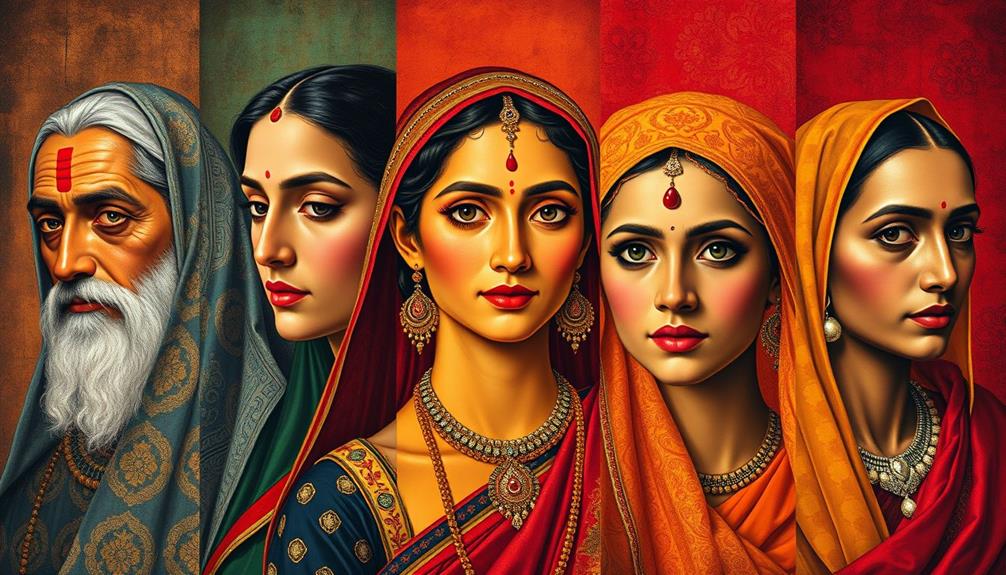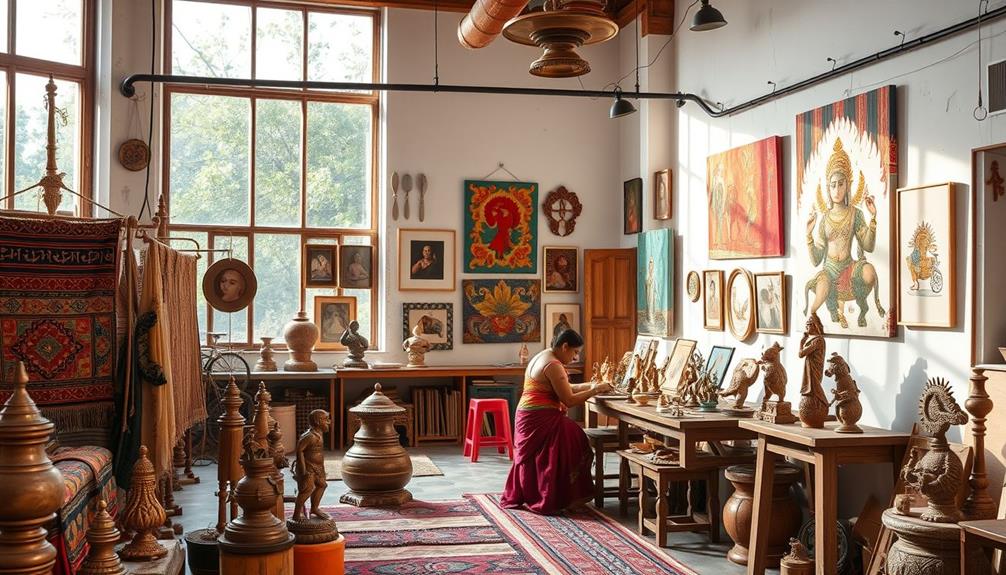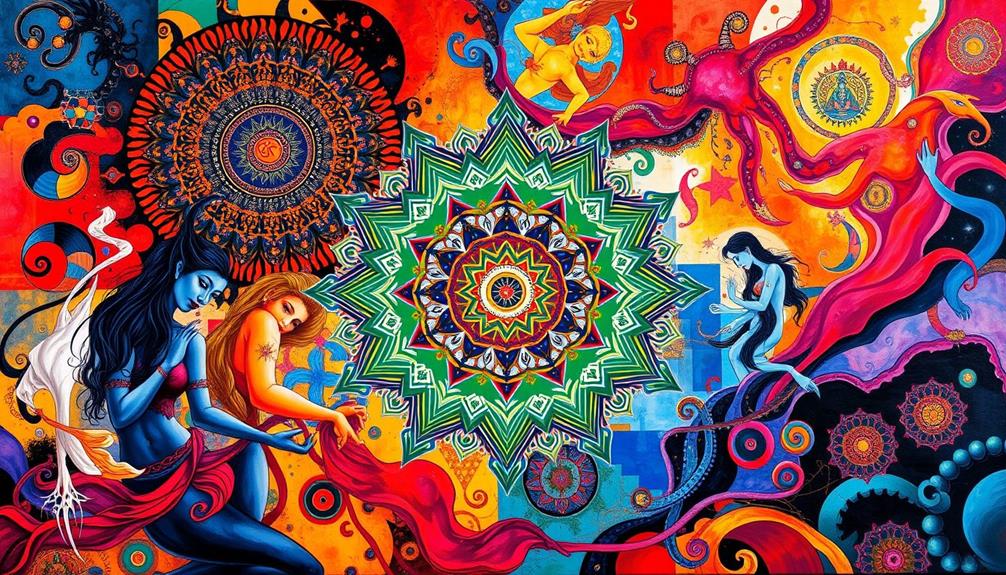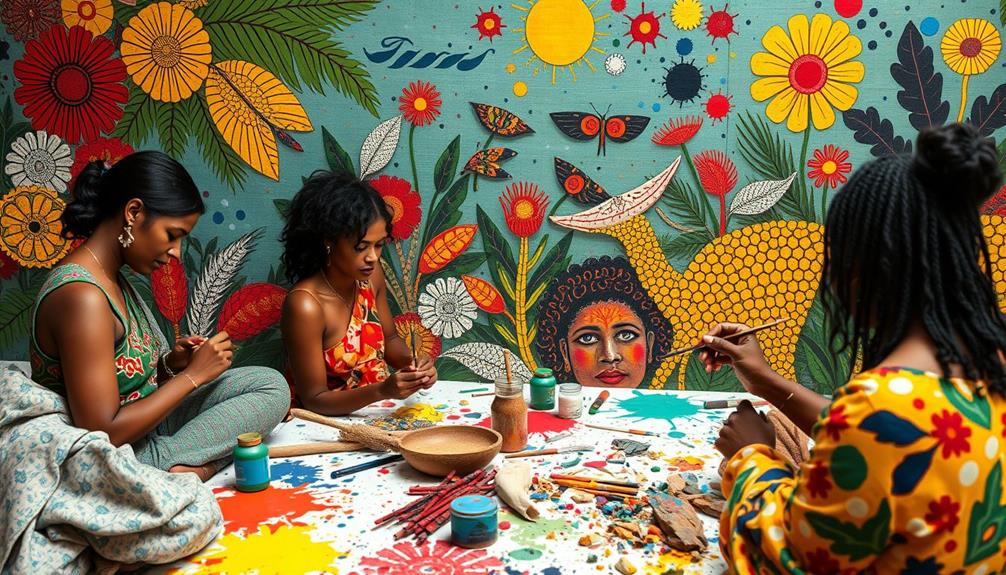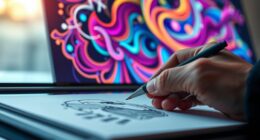The evolution of portrait painting in Indian art is a fascinating journey through time. It begins with early cave paintings and Indus Valley sculptures, showcasing humanity's desire to represent itself. The Mughal era introduced intricate styles, blending Persian and local influences, while British colonialism shifted focus towards realism. With the rise of photography, artists adapted their techniques, favoring quick, natural likenesses. Modern movements emphasized personal narratives and cultural contexts, reflecting contemporary issues. Throughout this evolution, portraiture has remained a powerful medium for storytelling and expression, leading to exciting developments in today's art scene that you won't want to miss.
Key Takeaways
- Indian portrait art originated with cave paintings and early sculptures from the Indus Valley civilization, showcasing human figures' detailed representation.
- The Mughal period introduced a blend of Persian and local traditions, emphasizing decorative elements and idealized representations in portraiture.
- British colonial influence shifted portraiture towards realism, with artists like Raja Ravi Varma incorporating European techniques into Indian themes.
- The rise of photography in the 19th century transformed portrait practices, leading to quicker, more accurate representations and collaboration between artists and photographers.
- Contemporary portrait artists blend traditional styles with modern themes, addressing socio-political issues and reviving techniques like miniature painting.
Origins of Indian Portrait Art
The origins of Indian portrait art reveal a captivating journey through time, starting around 30,000 years ago with the striking cave paintings found in the Bhimbetka rock shelters of Madhya Pradesh.
These early cave paintings mark an important beginning in the evolution of visual representation in India. Curiously, this transformative approach to visual aesthetics mirrors the innovative spirit seen in artistic journeys today.
Fast forward to the Indus Valley civilization, around 4,500 years ago, where sculptures like the Dancing Girl and the Priest-King bust showcased some of the earliest forms of portraiture, capturing the essence of human figures with remarkable detail.
As you explore further, the Ajanta caves, emerging post 2nd century BCE, display numerous depictions of Buddhist figures and humans, reflecting early portrait styles that hinted at a growing sophistication in artistic traditions.
These artworks not only served religious purposes but also hinted at the individual characteristics of their subjects.
The Mughal period, beginning in the 16th century, greatly evolved Indian portrait art, especially under Emperor Akbar, where portrait painting flourished in royal courts.
Influences from Iranian and European art during this time led to the development of complex portrait styles, blending local and foreign artistic traditions, setting the stage for future artistic endeavors in India.
Mughal Influence on Portraiture
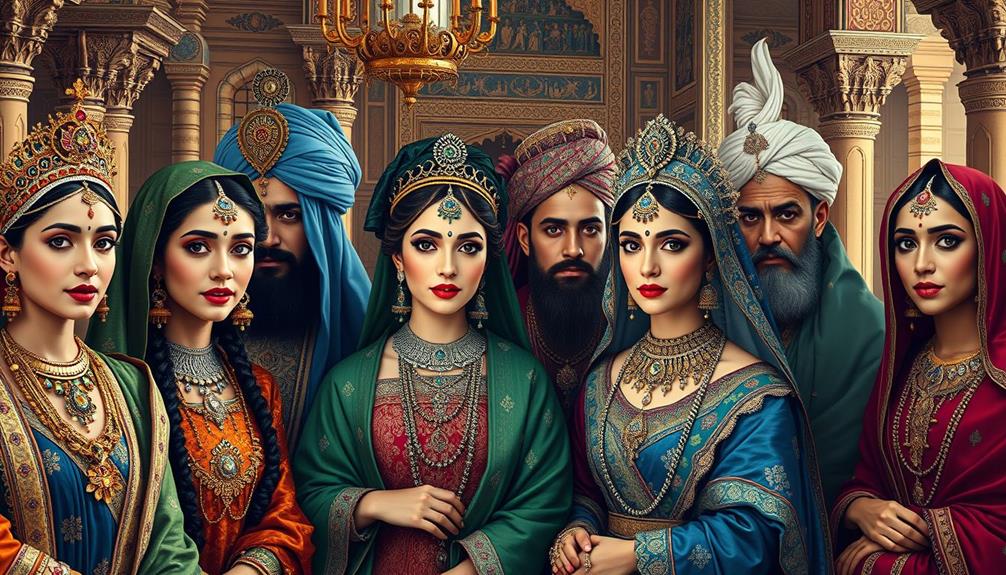
Mughal influence on portraiture transformed Indian art in profound ways, blending Persian aesthetics with local traditions. Under Emperor Akbar's reign, from 1556 to 1605, formal portrait painting emerged, laying the groundwork for future developments.
Mughal portraiture emphasized decorative elements and idealized representations, often prioritizing symbolic storytelling over true likenesses. This rich artistic tradition mirrors the complexities of human relationships, as seen in how trust issues in relationships can affect personal connections.
Artists like Manohar Das and Govardhan innovated portrait techniques, using intricate details and vibrant colors to reflect their subjects' status and personality.
As the 17th century unfolded, European artistic influences, especially from Jesuit missionaries, began to seep into Mughal portraiture. This led to a gradual integration of realistic techniques, enhancing the portrayal of figures.
The pinnacle of Mughal portraiture arrived during Jahangir's reign from 1605 to 1627, known for his passion for naturalism and psychological depth. He supported artists who captured not just the physical appearance but also the essence of their subjects.
This era marked a significant shift in Indian art, where the balance between decorative flair and realistic representation became a hallmark of Mughal portrait painting, ultimately shaping the trajectory of portraiture in India.
British Colonial Impact

During British colonial rule, you'll see a marked shift toward realism in portraiture, as artists began to adopt techniques that moved away from the ornate styles of Mughal art.
This period also transformed the gift culture, with commissioned portraits serving as diplomatic tools that showcased both power and cultural identity.
Additionally, much like the diversification of retirement portfolios, artists began to incorporate varied influences and styles into their work, reflecting the complex cultural exchanges of the time.
As you explore this evolution, consider how these changes shaped the way Indian art was perceived and created.
Realism in Portraiture
Realism in portraiture emerged as a significant shift in Indian art due to British colonial influence in the mid-18th century. This alteration marked a departure from the decorative symbols of Mughal miniature portraits, paving the way for a deeper exploration of individuality and emotion.
Indian artists, particularly Raja Ravi Varma, played a vital role during this transformation. He blended European techniques, like chiaroscuro and perspective, with local themes, creating empathy portraits that depicted sitters as complex psychological entities. The establishment of art schools under British rule further facilitated this evolution, exposing artists to Western academic realism and innovative styles.
Additionally, the introduction of photography in the 1830s revolutionized portrait painting. It allowed for more accurate representations, challenging traditional methods and enriching the realism in portraiture.
| Influence | Key Elements | Impact on Portraiture |
|---|---|---|
| British Colonialism | Introduction of realism | Shift from decorative to emotional depictions |
| Raja Ravi Varma | Blend of techniques | Emergence of empathy portraits |
| Art Schools | Training in academic realism | Standardization of styles |
Through these developments, realism in portraiture became an essential aspect of Indian art, merging tradition with new ideas.
Gift Culture Evolution
The evolution of portrait painting in India took on a new dimension with the rise of gift culture during British colonial rule. Indian rulers began commissioning portrait paintings of themselves as gifts for British Company officials, replacing the traditional Mughal practice of offering lavish items. This shift not only solidified diplomatic ties but also elevated the rulers' status in the eyes of the British.
As marriages were often influenced by common causes of divorce, the importance of maintaining powerful connections through art became increasingly evident among Indian elites.
The establishment of British art schools introduced formal training in portrait painting, which promoted European naturalism among Indian artists. You'd see artists like Raja Ravi Varma blending these Western techniques with Indian subjects, creating a unique fusion of traditional Indian art and European styles. This adaptation marked a notable transformation in artistic practices, as Indian artists began embracing new perspectives and methods.
As gift culture flourished during British colonization, it notably altered the trajectory of portrait painting in India. The commissioned portraits became symbols of power and prestige, reflecting the changing dynamics between the colonizers and the colonized.
This evolution not only enriched the art form but also laid the groundwork for future artistic endeavors in the subcontinent.
The Rise of Photography
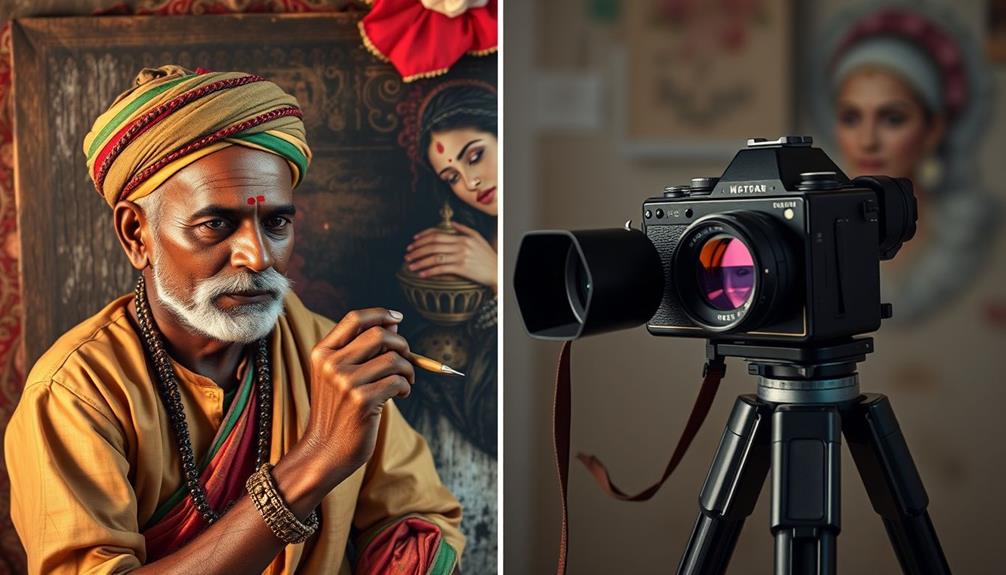
The rise of photography in the 19th century transformed how artists approached portraiture, pushing them to adapt their techniques. This technological advancement not only allowed for quicker sessions but also encouraged artists to explore new styles, such as incorporating sustainable home decor principles into their work.
Instead of lengthy sittings for painted portraits, you could now capture a likeness quickly and accurately with a camera. This shift not only redefined artistic methods but also expanded the range of subjects represented in portrait art, making it more relatable to the everyday person.
Impact on Artistic Techniques
A significant shift in artistic techniques emerged with the rise of photography in the 19th century, profoundly influencing portrait painting. This revolution brought about new ways for artists to capture likenesses, making it quicker and more cost-effective. The daguerreotype, for example, created detailed and lifelike representations, pushing artists to adapt to remain relevant in the evolving art world.
As artists navigated this change, they often found themselves considering the flow of energy in their creations, recognizing how energetic blockages could impact their artistic expression and output. Energy pathways for health became an essential aspect for many, as a clear and focused mindset was vital for successful adaptation to these new techniques.
- Collaboration between portrait artists and photo studios flourished, blending painting and photography.
- Hand-tinted photographs showcased artists' ability to infuse color, blurring the lines between the two mediums.
- The shift from live sittings to studio-based work democratized portraiture, making it accessible to a broader audience.
As Indian portrait paintings began to embrace these changes, European influences became more pronounced, leading to a unique fusion of realism and traditional techniques.
Artists had to navigate the new patronage landscape, where photography's efficiency often overshadowed the intricacies of painting. However, this challenge also inspired innovation, as artists sought to enhance their craft by integrating photographic references into their work.
The result was a dynamic evolution of artistic techniques, redefining how portraiture was created and perceived in both Indian and global contexts.
Shift in Subject Representation
With the advent of modern photography in 1839, Indian portraiture experienced a dramatic shift in subject representation. Photography introduced a quicker, more accessible alternative to traditional painted portraits, allowing for spontaneous and naturalistic representations that previously eluded artists.
The evolution of AI in Cybersecurity has also influenced various artistic forms, providing tools for artists to enhance their creative processes. The daguerreotype process enabled you to capture realism in ways that painted portraits simply couldn't match.
As photography gained traction, collaboration between portrait artists and photography studios flourished. Artists began using photographs as references, blending techniques that enhanced the quality and accuracy of their work.
This partnership spurred a new era in Indian portraiture, where the essence of traditional representation met the precision of photography.
The Shift to Modern Styles
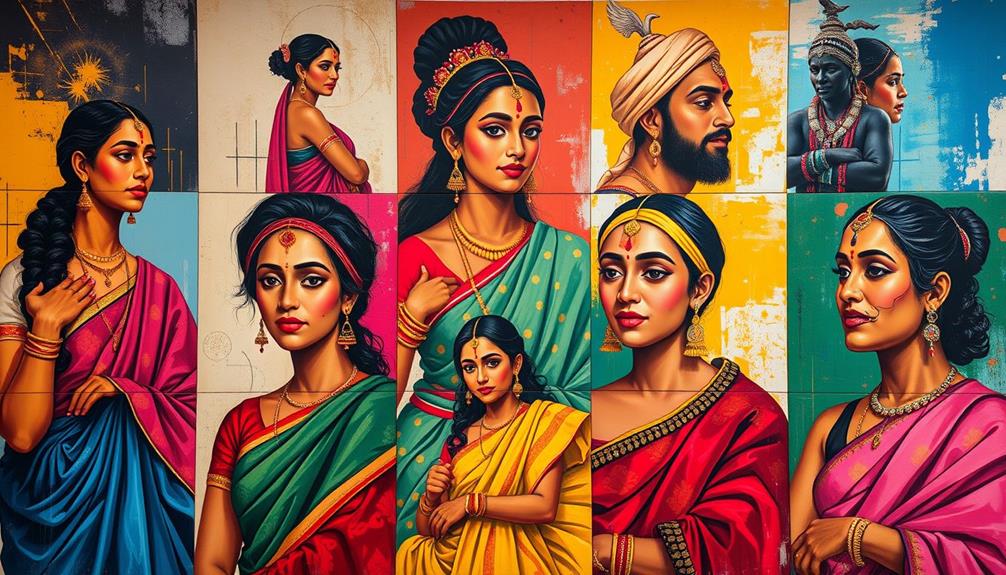
Frequently, portrait painting in India has undergone dramatic transformations, particularly during the early 20th century. This era marked a significant shift from European naturalism, influenced by the turmoil of the World Wars and the Indian independence movement.
Artists began to embrace modern artistic practices that prioritized emotive expressions and individualistic styles, reflecting a growing awareness of the impact of small mistakes in their techniques and narratives. This deeper exploration of cultural narratives can be seen as a manifestation of the benefits of curiosity, where artists sought to innovate and redefine their art forms by engaging with diverse influences and perspectives the benefits of curiosity.
- The emergence of Bombay as a cultural hub led to the rise of the Bombay Progressive Artists and the Madras School.
- These groups redefined portraiture in India by employing stylized techniques and focusing on expressive, abstract forms.
- Technological advancements, like the integration of photography into painting, transformed traditional practices, moving away from live sittings to studio-based work.
This evolution of portrait painting reflects not just a change in technique but also a deeper exploration of cultural narratives.
The blending of traditional methods with modern influences continues to shape contemporary portraiture, allowing artists to push boundaries and explore new aesthetics. As you engage with these artworks, you'll notice how they convey personal stories and emotions, enriching the overall landscape of Indian art.
Cultural Narratives in Portraits
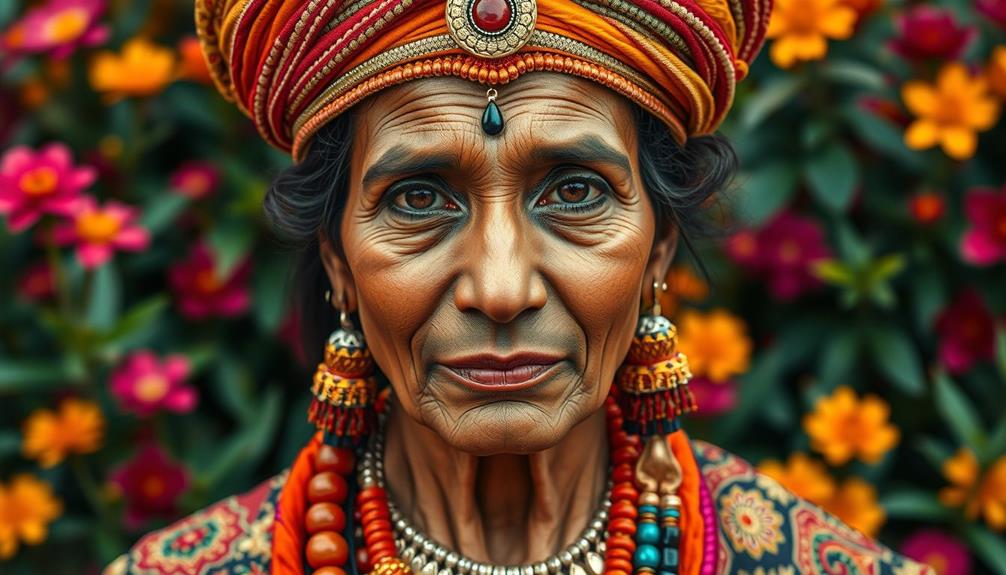
Portraits in Indian art serve as a mirror reflecting the rich tapestry of cultural narratives woven through clothing, posture, and background elements. In the Mughal era, portraiture often captured prominent figures, intertwining with significant socio-political movements that documented history. These works weren't just about likeness; they conveyed virtues, social status, and the broader themes of identity and heritage within the community.
Much like celebrity portraits that reflect evolving dynamics in personal relationships, Indian portraiture encapsulates the essence of its time, capturing the spirit of its subjects. Celebrity relationships and dynamics can inform our understanding of how identity is portrayed across cultures.
Miniature painting emerged as a distinctive art form, integrating local traditions with Mughal and European influences, showcasing unique cultural stories. Each region developed its signature style, encapsulating local narratives while preserving a sense of collective identity.
As you investigate deeper into these portraits, you'll notice how they reinforce the heritage of Indian society, transcending individual representation.
In post-independence India, the socio-political climate shifted the focus toward personal narratives and emotive expressions within portraiture. Artists began to explore evolving cultural identities, reflecting the complexities of modern Indian life.
This evolution emphasizes how portrait painting continues to serve as a powerful medium for storytelling, allowing you to connect with the intricate layers of Indian culture and its dynamic history.
Notable Portrait Artists
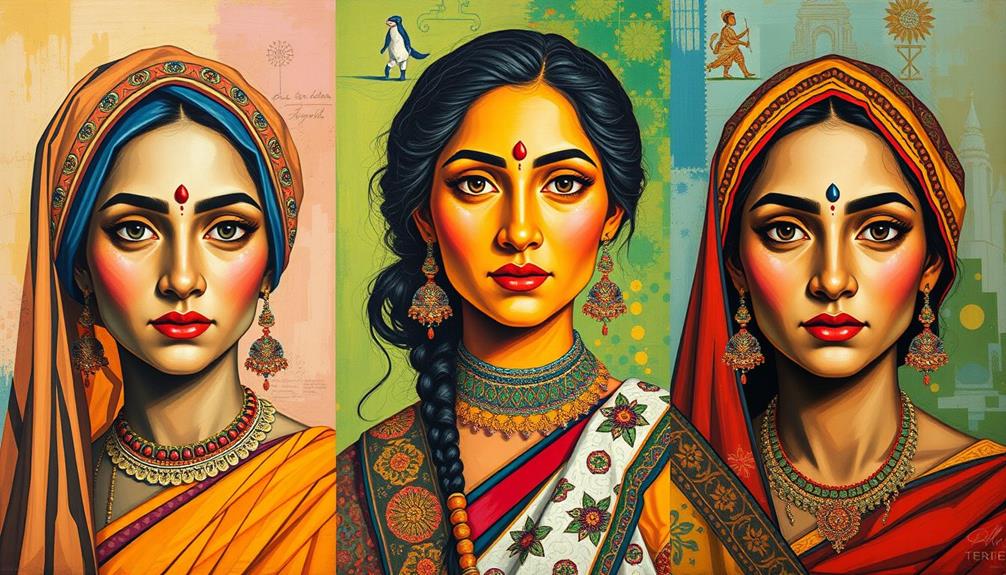
Across the landscape of Indian art, several remarkable portrait artists have made substantial contributions that shaped the genre. Each artist brought unique perspectives, blending traditional Indian themes with European techniques to create a rich tapestry of portrait painting. The evolution of artistic techniques during this period parallels the growing interest in holistic wellness practices, such as essential oils for hair growth, which emphasize the importance of natural beauty and well-being.
- Raja Ravi Varma (1848-1906) is celebrated for revitalizing portrait painting by merging mythological subjects with contemporary styles. His influence extends to countless artists who followed.
- M. V. Dhurandhar (1867-1938) earned acclaim for his exceptional figurative art and dedication to art education, winning multiple gold medals that highlighted his expertise in portraiture.
- Pestonji Bomanji (1851-1938) particularly captured cultural narratives in his work, particularly through "The Parsi Girl," which illustrated the evolving roles of Parsi women in society.
Moreover, Ghasiram Hardev Sharma (1869-?) innovatively combined traditional temple art with modern techniques, reflecting the changing dynamics of Indian portraiture.
Contemporary Portrait Practices
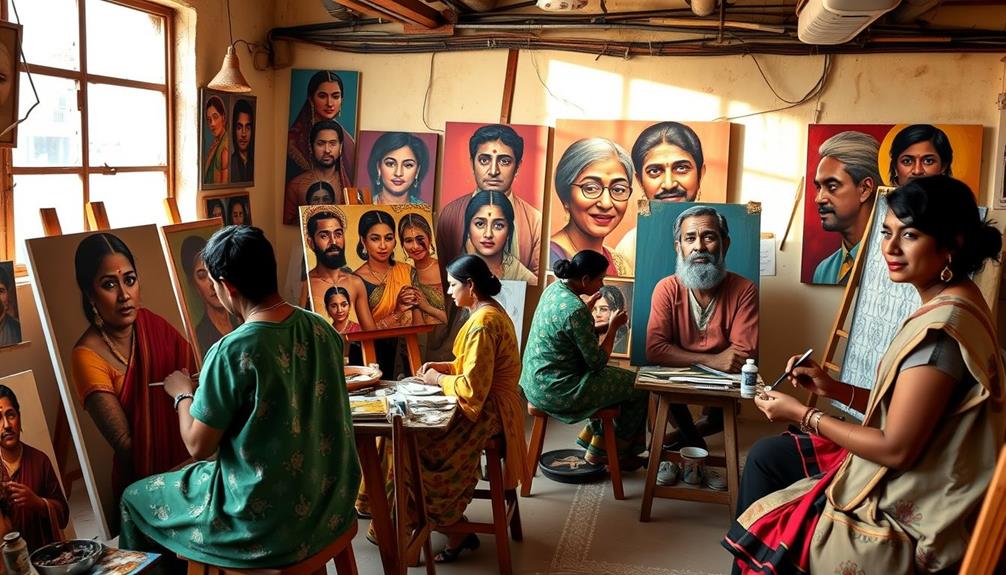
In today's art scene, contemporary portrait practices in India are thriving as artists blend traditional techniques with modern themes to express personal narratives and socio-political contexts.
You'll find that many artists, like The Singh Twins, have revitalized miniature styles to tackle pressing contemporary issues such as migration and multiculturalism. This fusion showcases the enduring relevance of traditional art forms.
The integration of digital mediums has transformed the landscape of portrait creation, allowing you to see innovative aesthetics that still honor cultural heritage.
Post-independence, movements like the Bombay Progressive Artists' Group shifted focus from royal depictions to more expressive and abstract forms, reflecting changing societal attitudes.
Contemporary portraits often showcase vibrant colors and innovative techniques, such as chiaroscuro, to enhance emotional depth and realism.
This approach highlights the seamless blend of Indian and Western artistic influences, creating a dynamic visual language.
As you explore these contemporary portrait practices, you'll discover how artists navigate their identities and societal challenges, making their work not only visually appealing but deeply resonant with today's cultural dialogues.
Frequently Asked Questions
How Has Indian Painting Evolved?
Indian painting's evolved notably over millennia, reflecting cultural changes. You've seen it shift from ancient depictions to intricate styles influenced by various cultures, culminating in modern expressions that embrace individuality and socio-political themes.
Who Started Portrait Painting in India?
You might say the Mughal court ignited portrait painting in India, especially under Emperor Akbar. His passion for art birthed intricate miniature masterpieces, setting the stage for future artists to explore this vibrant tradition.
What Is the Origin of Portrait Painting?
You'll find the origin of portrait painting goes back tens of thousands of years, starting with cave paintings and evolving through ancient sculptures, showcasing humanity's desire to capture likeness and express identity throughout history.
How and in What Ways Was Indian Painting Influenced by European Art Form?
You might think Indian painting remained untouched by European influence, but it actually embraced techniques like realism and perspective. Artists incorporated these styles, blending them with local themes, enriching the art scene markedly.
Conclusion
In exploring the evolution of portrait painting in Indian art, you see how it mirrors the rich tapestry of the nation's history. From Mughal splendor to modern interpretations, each stroke tells a story, revealing identity and culture. As you appreciate these portraits, remember they're not just images; they're windows into the soul of a civilization. Like a river that shapes the land, portraiture continues to flow and adapt, reflecting the vibrant spirit of India today.
